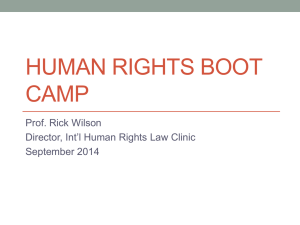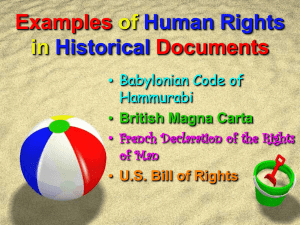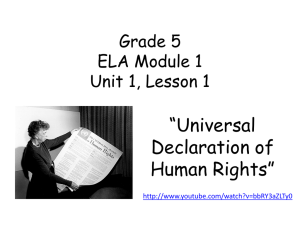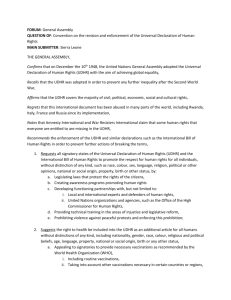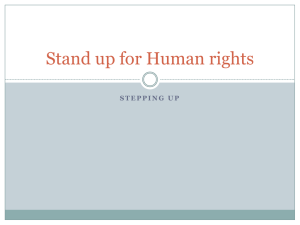5m1.1l8
advertisement
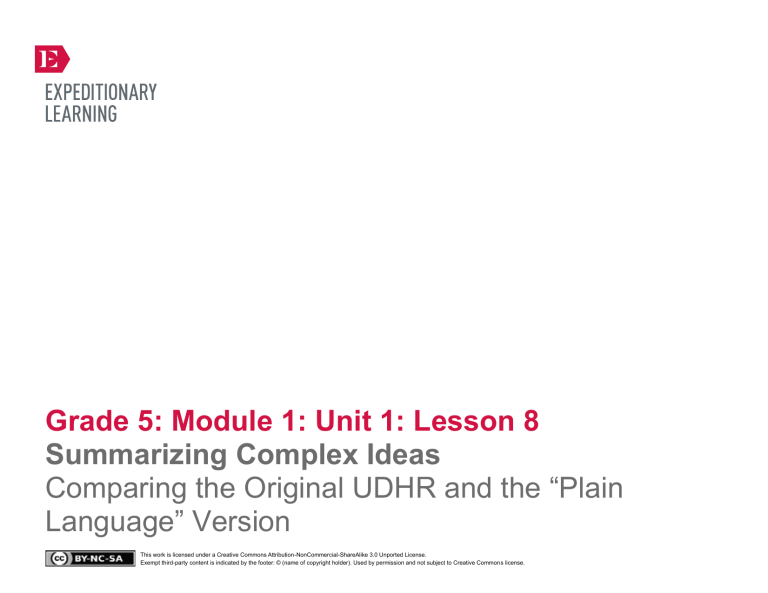
Grade 5: Module 1: Unit 1: Lesson 8 Summarizing Complex Ideas Comparing the Original UDHR and the “Plain Language” Version This work is licensed under a Creative Commons Attribution-NonCommercial-ShareAlike 3.0 Unported License. Exempt third-party content is indicated by the footer: © (name of copyright holder). Used by permission and not subject to Creative Commons license. GRADE 5: MODULE 1: UNIT 1: LESSON 8 Summarizing Complex Ideas: Comparing the Original UDHR and the “Plain Language” Version Long-Term Targets Addressed (Based on NYSP12 ELA CCLS) I can use quotes to explain the meaning of informational texts. (RI.5.1) I can compare and contrast multiple accounts of the same event or topic. (RI.5.6) I can use common Greek and Latin affixes (prefixes) and roots as clues to help me know what a word means. (L.5.4) I can write for a variety of reasons. (W.5.10) Supporting Learning Targets Ongoing Assessment • I can explain why certain words in the original UDHR are repeated. • Vocabulary flash card baggies • I can compare the original UDHR, the Plain Language Version, and my own summaries of specific UDHR articles by focusing on specific word choice. • UDHR rewrites • Opinion writing (journal entry) • I can skim and scan the original UDHR looking for repeated words. Agenda Teaching Notes 1. Opening A. Engaging the Reader: (5 minutes) B. Interactive Words (10 minutes) 2. Work Time A. Repeated Words and Phrases in the UDHR: Why Do They Matter? (15 minutes) B. Word Choice and Meaning: Comparing the Original UDHR to the Plain Language Version (20 minutes) 3. Closing and Assessment A. Opinion Writing: What Is Lost and Gained in the Plain Language Version? (10 minutes) 4. Homework • The Interactive Words activity helps students socially construct meaning. There is no “right” arrangement of the words/arrows, etc. It is being used in this lesson as quick review, but by adding a writing component in which students explain their reason, it could become deeper learning or even an assessment. Copyright © 2013 by Expeditionary Learning, New York, NY. All Rights Reserved. • Interactive Words is transferable across the day; use it in any area in which students are learning new words. You might consider laminating the arrow/equals cards found in the supporting materials for this lesson and storing them for other activities. • Review: Write-Pair-Share protocol (see Appendix 1). • Post: Learning targets. NYS Common Core ELA Curriculum • G5:M1:U1:L8 • July 2013 • 1 GRADE 5: MODULE 1: UNIT 1: LESSON 8 Summarizing Complex Ideas: Comparing the Original UDHR and the “Plain Language” Version Lesson Vocabulary Materials analyze, versions, plain, proclaim, impart, promote, indispensable, aspiration, quote, universal • Universal Declaration of Human Rights (from Lesson 1) Note: Do NOT define universal in advance, since students spend work time considering the morphology of this key term. • UDHR note catchers (from Lessons 1, 6, and 7; student copies, completed) • Index cards (additional, for students’ vocabulary flash cards) • Interactive Words symbols (see supporting materials) • Vocabulary flash cards (begun in Lesson 3; student-created on index cards) • Universal Declaration of Human Rights—Plain Language Version (one per student) • Sticky notes (one small packet per pair) • Document camera Opening Meeting Students’ Needs A. Engaging the Reader (5 minutes) • Use vocabulary learning strategies: prefixes, root words, suffixes, cognates, and context • Ask students to share with a partner how it went explaining the complex Universal Declaration of Human Rights to someone at home. • Ask a student to read aloud the first learning target: * “I can explain why certain words in the UDHR are repeated.” • Underline or circle the word repeated. Ask students to explain the meaning of the word, pointing out the prefix re - and that it means “again.” • ELL language acquisition can be facilitated by interacting with native speakers of English who provide models of language. • Ask a student to read aloud the second learning target: “I can compare the original UDHR, the Universal Declaration of Human Rights—Plain Language Version, and my own summaries of specific UDHR articles.” • Remind students how challenging the original UDHR is, and how hard they have been working to really understand the words and ideas. Say: * “After reading closely, annotating some of the articles in the UDHR, and trying to explain an article at home, why might we want to rewrite it in simpler language?” • Invite a few students to share out, making sure their responses include the need for everyone to be able to understand the articles. Copyright © 2013 by Expeditionary Learning, New York, NY. All Rights Reserved. NYS Common Core ELA Curriculum • G5:M1:U1:L8 • July 2013 • 2 GRADE 5: MODULE 1: UNIT 1: LESSON 8 Summarizing Complex Ideas: Comparing the Original UDHR and the “Plain Language” Version Opening Meeting Students’ Needs B. Interactive Words (10 minutes) • This activity appeals to visual and spatial learners. • Tell students that they are going to do a brief activity to continue to build their knowledge about vocabulary in the UDHR. • Ask students to partner up. One partner should get his or her voabulary flash cards and take out the flash cards. • Distribute the Interactive Words symbols (in supporting materials) and a small packet of sticky notes. • Ask students to use the symbols and arrange their flash cards on their desktops in an order that shows the relationships between the words. They can add words and symbols on sticky notes as needed. For example, they might arrange “fundamental + right = dignity.” Students should use all of their flash cards but do not need to use all of their symbols. • Once completed, have students look at another pair’s work. Ask partners to explain their arrangement to the other set of partners. • Ask students to store the symbols in their flash card baggies. Use this activity whenever you have some free time. Copyright © 2013 by Expeditionary Learning, New York, NY. All Rights Reserved. NYS Common Core ELA Curriculum • G5:M1:U1:L8 • July 2013 • 3 GRADE 5: MODULE 1: UNIT 1: LESSON 8 Summarizing Complex Ideas: Comparing the Original UDHR and the “Plain Language” Version Work Time Meeting Students’ Needs A. Repeated Words and Phrases in the UDHR: Why Do They Matter? (15 minutes) • For ELLs, consider providing extended time for tasks and answering questions in class discussions. • Make sure every student has a copy of the full original UDHR. Distribute clean copies if necessary. Also be sure they have their UDHR note-catchers from previous lessons • Place students in pairs. Set purpose. Tell students that readers approach text differently depending on their purpose. Say: “During most of this unit, we have been reading very slowly, closely, and deliberately, taking time to try to understand every single word. Today, I am going to ask you to do something else: ‘skim and scan.’” • Ask a student to remind the class what it means to “skim and scan”: to read very quickly looking for something specific. If necessary, place the original UDHR on the document camera and briefly model moving a finger quickly across the page to show “skimming.” • Give students 2 to 3 minutes to work individually to skim all 30 articles, looking for repeated words or phrases. Remind them that the purpose is not to understand everything, but to find words that show up over and over. • Ask students to talk with a partner about the repeated words they found. • Ask students to remain with their partner but to listen as a whole group. Project a copy of the UDHR and ask the class to notice which words are repeated often. Likely many students will notice repetitions such as everyone, no one, without limitation, or without discrimination. • Ask: * • Defining key verbs for learning actions (e.g., introduction and skim) helps ELLs and other struggling learners understand and engage more fully in the task. • Physically demonstrating key verbs (e.g., showing how to skim by running your finger across a page of text) reinforces definitions. • Some vocabulary is not academic or domain- specific, and students may benefit from instruction or review: original, simple, without, everyone, no one. • When possible, provide text or materials in students’ home language. “What was the purpose of including these words and phrases and repeating them so often?” • Have students Write-Pair-Share in response to this question. • During the “share,” be sure to discuss that the authors crafted the document to emphasize the idea of universal. • Linger on this word, since it carries the central message of the UDHR. Ask: * “What does ‘universal’ mean?” • Provide ELLs bilingual word-for-word translation dictionaries or online translation sources such as Google Translate to assist with comprehension. • Use the concept of word roots and morphemes to further explore the word’s morphology: * “What other word that you know do you see in the word ‘universal’?” • Students likely will say “universe.” Ask: * “And what does universe mean?” • Students likely will refer to the physical universe, a vast space, “the entire universe.” • Probe, focusing on the fact that words often have various meanings: * “In the UDHR, when the authors use the word universal, what meaning do they intend? Are they referring to the physical universe, planets, galaxies, etc.?” Copyright © 2013 by Expeditionary Learning, New York, NY. All Rights Reserved. NYS Common Core ELA Curriculum • G5:M1:U1:L8 • July 2013 • 4 GRADE 5: MODULE 1: UNIT 1: LESSON 8 Summarizing Complex Ideas: Comparing the Original UDHR and the “Plain Language” Version Meeting Students’ Needs Work Time (continued) • Invite students to turn and talk. Then have a few share out. Drawing on their thinking to the extent possible, guide the class to realize that the authors of the UDHR sought to emphasize that human rights have no exceptions. • Point out to students the al ending in universal: “The al at the end of this word is a common way to signal an adjective. So universal describes human rights.” • Invite them to add notes in the example/non-example boxes to clarify what is meant by universal human rights. • Point out to students how good they have gotten at building a full understanding of a word by considering it in depth across many days. Copyright © 2013 by Expeditionary Learning, New York, NY. All Rights Reserved. NYS Common Core ELA Curriculum • G5:M1:U1:L8 • July 2013 • 5 GRADE 5: MODULE 1: UNIT 1: LESSON 8 Summarizing Complex Ideas: Comparing the Original UDHR and the “Plain Language” Version Work Time Meeting Students’ Needs B. Word Choice and Meaning: Comparing the Original UDHR to the Plain Language Version (20 minutes) • Tell students that many organizations have simplified the UDHR to make it easier to understand. Today, they will look at one of those simpler versions, called the Plain Language Version. Explain that plain in this context means “simple.” • Consider partnering an ELL with a student who speaks the same home language when discussion of complex content is required. This can allow them to have more meaningful discussions and clarify points in their home language. • Distribute the Universal Declaration of Human Rights—Plain Language Version to each student. Ask them to skim the document looking for repeated words or phrases, as they did with the original. Then, as before, invite them to turn and talk. (Likely they will notice similar phrases, such as “everyone” or “nobody.”) • Providing choice and extensions naturally differentiates based on students’ readiness and interest. • Remind students how they “chunked” the UDHR by putting boxes around specific articles the class would focus on. Ask students to do the same with their Plain Language Version: Draw one box per article around the same 11 articles: 1, 2, 3, 6, 14, 16, 17, 20, 23, 25, and 26. • If appropriate, coach ELLs or struggling readers to choose shorter articles. To stretch stronger readers, encourage them to choose different articles than the 10 the class has been reading closely. • Share with students that the authors of the UDHR wanted everyone on the planet to know, understand, and honor the rights described in the document. Invite them to consider the importance of being able to explain the ideas embodied in this document in simple language that anyone could understand and embrace. • Ask students to focus on one or two articles (likely the ones they became “experts” on in Lesson 7, but they may choose any). Invite them to talk with a partner about the comparisons: * “What words are the same?” * “What words are different?” • Ask: * “Do you think this Plain Language Version is better or worse than the original? Why?” • Many students likely will say they think the Plain Language Version is easier. (They may even express frustration about why they didn’t get to read this easier document in the first place.) Some may comment that they liked the original because it was much more detailed. • Tell students that simplified versions serve a purpose, making harder things easier to understand. Authors must choose words carefully, because anything changed from one version to another runs the risk of losing some of the original meaning. • Ask pairs to choose one or two specific articles to focus on for the next task. • Ask them to consider: * “What is gained in the Plain Language Version? In other words, how is it better?” • Invite students to Think-Pair-Share. During the sharing, probe them to provide examples of words or phrases from specific articles. Copyright © 2013 by Expeditionary Learning, New York, NY. All Rights Reserved. NYS Common Core ELA Curriculum • G5:M1:U1:L8 • July 2013 • 6 GRADE 5: MODULE 1: UNIT 1: LESSON 8 Summarizing Complex Ideas: Comparing the Original UDHR and the “Plain Language” Version Meeting Students’ Needs Work Time (continued) • Then ask: * “What is lost in the Plain Language Version? In other words, how is it worse?” • Invite them again to Think-Pair-Share. During the sharing, probe them to provide examples of words or phrases from specific articles. • Ask students to get out their UDHR note-catcher, if they haven’t already. Invite them to either revise their paraphrase/ summary of an article or to add in key words from the original that they now think are particularly important for carrying the meaning of the article. Copyright © 2013 by Expeditionary Learning, New York, NY. All Rights Reserved. NYS Common Core ELA Curriculum • G5:M1:U1:L8 • July 2013 • 7 GRADE 5: MODULE 1: UNIT 1: LESSON 8 Summarizing Complex Ideas: Comparing the Original UDHR and the “Plain Language” Version Closing and Assessment Meeting Students’ Needs A. Opinion Writing: What Is Lost and Gained in the Plain Language Version? (10 minutes) • Ask students to draw a line underneath their last journal entry and copy the question: • Consider allowing students to draw their observations, ideas, or notes when appropriate. * “What is gained in the Plain Language Version of the UDHR? What is lost?” • Tell them that they may focus just on one article or write about the document more broadly. Either way, they should use quotes from the original UDHR and the Plain Language Version as evidence for their answer. • Be aware that vocabulary can be overwhelming for some ELLs. They may be working on basic word meaning, and that is appropriate. • If time permits, ask students to share their writing with a partner. Homework Meeting Students’ Needs • Show someone at home both versions of the UDHR: the original and the Plain Language Version. Talk with that person about which version you prefer, and why. What is gained and lost when an original primary source (historical document) is simplified? What does the phrase “lost in translation” mean? Copyright © 2013 by Expeditionary Learning, New York, NY. All Rights Reserved. NYS Common Core ELA Curriculum • G5:M1:U1:L8 • July 2013 • 8 Grade 5: Module 1: Unit 1: Lesson 8 Supporting Materials This work is licensed under a Creative Commons Attribution-NonCommercial-ShareAlike 3.0 Unported License. Exempt third-party content is indicated by the footer: © (name of copyright holder). Used by permission and not subject to Creative Commons license. GRADE 5: MODULE 1: UNIT 1: LESSON 8 Interactive Words Symbols Copyright © 2013 by Expeditionary Learning, New York, NY. All Rights Reserved. NYS Common Core ELA Curriculum • G5:M1:U1:L8 • July 2013 • 10 GRADE 5: MODULE 1: UNIT 1: LESSON 8 Interactive Words Symbols Copyright © 2013 by Expeditionary Learning, New York, NY. All Rights Reserved. NYS Common Core ELA Curriculum • G5:M1:U1:L8 • July 2013 • 11 GRADE 5: MODULE 1: UNIT 1: LESSON 8 Interactive Words Symbols Copyright © 2013 by Expeditionary Learning, New York, NY. All Rights Reserved. NYS Common Core ELA Curriculum • G5:M1:U1:L8 • July 2013 • 12 GRADE 5: MODULE 1: UNIT 1: LESSON 8 Universal Declaration of Human Rights – Plain Language Version 1 When children are born, they are free and each should be treated in the same way. They have reason and conscience and should act towards one another in a friendly manner. 2 Everyone can claim the following rights, despite - a different sex - a different skin color - speaking a different language - thinking different things - believing in another religion - owning more or less - being born in another social group - coming from another country It also makes no difference whether the country you live in is independent or not. 3 You have the right to live, and to live in freedom and safety. 4 Nobody has the right to treat you as his or her slave and you should not make anyone your slave. 5 Nobody has the right to torture you. 6 You should be legally protected in the same way everywhere, and like everyone else. 7 The law is the same for everyone; it should be applied in the same way to all. 8 You should be able to ask for legal help when the rights your country grants you are not respected. 9 Nobody has the right to put you in prison, to keep you there, or to send you away from your country unjustly, or without good reason. 10 If you go on trial this should be done in public. The people who try you should not let themselves be influenced by others. Copyright © 2013 by Expeditionary Learning, New York, NY. All Rights Reserved. NYS Common Core ELA Curriculum • G5:M1:U1:L8 • July 2013 • 13 GRADE 5: MODULE 1: UNIT 1: LESSON 8 Universal Declaration of Human Rights – Plain Language Version 11 You should be considered innocent until it can be proved that you are guilty. If you are accused of a crime, you should always have the right to defend yourself. Nobody has the right to condemn you and punish you for something you have not done. 12 You have the right to ask to be protected if someone tries to harm your good name, enter your house, open your letters, or bother you or your family without a good reason. 13 You have the right to come and go as you wish within your country. You have the right to leave your country to go to another one; and you should be able to return to your country if you want. 14 If someone hurts you, you have the right to go to another country and ask it to protect you. You lose this right if you have killed someone and if you, yourself, do not respect what is written here. 15 You have the right to belong to a country and nobody can prevent you, without a good reason, from belonging to a country if you wish. 16 As soon as a person is legally entitled, he or she has the right to marry and have a family. In doing this, neither the color of your skin, the country you come from nor your religion should be impediments. Men and women have the same rights when they are married and also when they are separated. Nobody should force a person to marry. The government of your country should protect you and the members of your family. 17 You have the right to own things and nobody has the right to take these from you without a good reason. 18 You have the right to profess your religion freely, to change it, and to practice it either on your own or with other people. 19 You have the right to think what you want, to say what you like, and nobody should forbid you from doing so. You should be able to share your ideas also—with people from any other country. 20 You have the right to think what you want, to say what you like, and nobody should forbid you from doing so. You should be able to share your ideas also—with people from any other country. Copyright © 2013 by Expeditionary Learning, New York, NY. All Rights Reserved. NYS Common Core ELA Curriculum • G5:M1:U1:L8 • July 2013 • 14 GRADE 5: MODULE 1: UNIT 1: LESSON 8 Universal Declaration of Human Rights – Plain Language Version 21 You have the right to take part in your country’s political affairs either by belonging to the government yourself or by choosing politicians who have the same ideas as you. Governments should be voted for regularly and voting should be secret. You should get a vote and all votes should be equal. You also have the same right to join the public service as anyone else. 22 The society in which you live should help you to develop and to make the most of all the advantages (culture, work, social welfare) which are offered to you and to all the men and women in your country. 23 You have the right to work, to be free to choose your work, to get a salary which allows you to support your family. If a man and a woman do the same work, they should get the same pay. All people who work have the right to join together to defend their interests. 24 Each work day should not be too long, since everyone has the right to rest and should be able to take regular paid holidays. 25 You have the right to have whatever you need so that you and your family: do not fall ill or go hungry; have clothes and a house; and are helped if you are out of work, if you are ill, if you are old, if your wife or husband is dead, or if you do not earn a living for any other reason you cannot help. Mothers and their children are entitled to special care. All children have the same rights to be protected, whether or not their mother was married when they were born. 26 You have the right to go to school, and everyone should go to school. Primary schooling should be free. You should be able to learn a profession or continue your studies as far as you wish. At school, you should be able to develop all your talents, and you should be taught to get on with others, whatever their race, religion, or country they come from. Your parents have the right to choose how and what you will be taught at school. 27 You have the right to share in your community’s arts and sciences, and any good they do. Your works as an artist, writer, or a scientist should be protected, and you should be able to benefit from them. 28 So that your rights will be respected, there must be an “order” which can protect them. This “order” should be local and worldwide. 29 You have duties toward the community within which your personality can only fully develop. The law should guarantee human rights. It should allow everyone to respect others and to be respected. 30 In all parts of the world, no society, no human being, should take it upon her or himself to act in such a way as to destroy the rights which you have just been reading about. This plain language version is given only as a guide. For an exact rendering of each principle, refer students to the original. This version is based in part on the translation of a text prepared in 1978 for the World Association for the School as an Instrument of Peace, by a research group of the University of Geneva, under the responsibility of Professor L. Massarenti. In preparing the translation, the group used a basic vocabulary of 2,500 words in use in the French-speaking part of Switzerland. Teachers may adopt this methodology by translating the text of the Universal Declaration in the language in use in their region. Copyright © 2013 by Expeditionary Learning, New York, NY. All Rights Reserved. NYS Common Core ELA Curriculum • G5:M1:U1:L8 • July 2013 • 15
